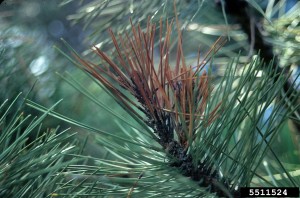By Rob Barrett
Many years ago, Pinus nigra or Austrian pine, became a staple in upstate New York landscapes. It was thought to be a perfect specimen, with deep green needles and symmetrical growth. It adapted to many different growing conditions and was salt-tolerant. It seemed to be relatively insect- and disease-resistant. We planted it everywhere: lining our yards, commercial properties, hedgerows, and housing complexes, very often in large clumps and too close together considering its mature size.
Traveling through our community today, you will see these trees in many stages of health. Some still look perfect, but not many. Others are almost completely bare with a few green needles at the top and a thick layer of brown needles on the ground below. Mostly, you will see mature trees with very thin foliage 50% to 75% up the tree with some green and brown above.
What happened to our perfect tree? The same thing that usually happens. We find something new and different. We over-plant without diversification. Everything is grand. Then we realize we have made a mistake.
Austrian pines have succumbed to a variety of diseases, compounded with harsh and highly variable weather conditions. Fungal pathogens that manifest themselves as tip and needle blights seem to be our biggest threat. There is a laundry list of these pathogens; we tend to suspect Dothistroma and Diplodia. As with most of fungal plant diseases, they thrive in wet weather, via splashing and dripping. You can see how these diseases might spread like wildfire, considering the trees are planted atop one another and our weather is conducive to optimal disease production.
What can we do? For trees that are already severely infected, removal is the best option.
However, if you’re up for the commitment there are a variety of treatments including spraying with registered fungicides at regular intervals in the spring. Timing, weather, pesticide regulation all hinder this approach. Another option is trunk injections with labeled products. Although these treatments provide some disease suppression, it should also be stated that they are by no means a cure and usually need to be repeated yearly.
Where practical prune out dead branches and rake up and destroy infected needles that have dropped. Water and lightly fertilize trees as needed. Trees 15 years or older are much more susceptible to these issues. As trees mature, reduce any other stresses including insect damage and water management. These added issues often compound the problem and accelerate decline.
Horticultural changes may be our best option. Preemptively remove trees that are unhealthy or thin out those that were planted too close together. Note that when looking at a group of Austrian pines you’ll see differences in their appearances because they’re raised from seed and this means there’s natural variation in resistance from plant to plant which can work to your advantage. When thinning out a stand of trees remove the worst and keep the best.
In a short time this tree has gone from the most-planted list to the do-not plant list. This may be a bit severe; there is a place for Austrian pine in the landscape. The answer lies in diversification. Plant a variety of trees. There are many other choices if you desire evergreens, but they all have their issues. Some good options are Norway spruce, white pine, and even some of the newer long needled pines that are showing some promise. Check with your nursery or consult an arborist for other varieties and planting recommendations.
Trees are an investment. Choose wisely and you will receive a strong return.
Rob Barrett is the manager of Plant Health Care at Ted Collins Tree and Landscape in Victor, NY.
Image of Diplodia on Austrian pine courtesy Ward Upham, Kansas State University, Bugwood.org.
Views: 2






